Study on the Influence of Thermodynamic Effects on the Characteristics of Liquid Nitrogen Cavitating Flow around Hydrofoils
Abstract
:1. Introduction
2. Numerical Calculation Methods and Verification
2.1. Computational Domain and Grid Division
2.2. The Control Equations
2.3. Boundary Conditions and Material Property Settings
2.4. Verification of the Numerical Calculation
3. Results Analysis and Discussion
3.1. Lift and Drag Characteristics
3.2. Analysis of Thermodynamic Effects on Cavitation-Bubble Growth and Vortex-Shedding Characteristics
3.2.1. Isothermal Cavitation
3.2.2. Thermodynamic Effect Cavitation
3.3. Influence of Thermodynamic Effects on the Pressure Field and Velocity Field
3.3.1. Isothermal Cavitation
3.3.2. Thermodynamic Effect Cavitation
4. Conclusions and Prospects
- The validated numerical model was then employed to simulate the cavitation flow around the NACA0015 hydrofoil in liquid nitrogen without considering the thermodynamic effects. It was observed that the small-scale vortices induced by the upstream development of the re-entrant jet were the primary cause of fragmentation within the main cavitation region. The shedding motion of the bubbles contributed to the integration of these vortices;
- Subsequently, the validated numerical model was utilized to simulate the cavitation flow around the NACA0015 hydrofoil in liquid nitrogen, this time taking into account the thermodynamic effects. It was observed that the cavitation effect was significantly diminished, resulting in a “mist-like” structure of the cavitation region. The incomplete development of the re-entrant jet upstream was identified as the fundamental reason for the inability of the cavitation cloud to detach as a whole;
- Irrespective of whether thermodynamic effects were considered or not, the re-entrant jet originated from the high-pressure, low-velocity region formed by the interaction of mainstream flows at the hydrofoil’s trailing edge. When thermodynamic effects were incorporated, the upstream development of the re-entrant jet faced greater obstacles, leading to the formation of larger-scale vortices compared to isothermal cavitation.
Author Contributions
Funding
Data Availability Statement
Conflicts of Interest
Abbreviations
| Acronyms | |
| CFD | Computational Fluid Dynamics |
| DDES | Delayed Detached Eddy Simulation |
| DES | Detached Eddy Simulation |
| PANS | Partially Averaged Navier–Stokes model |
| Symbols | |
| c | Chord length |
| α | Angle of attack |
| σ∞ | Incoming cavitation number |
| Cl | Lift coefficient |
| Cd | Drag coefficient |
| Pv | Saturation vapor pressure |
References
- Xiang, L.; Tan, Y.; Chen, H.; Xu, K. Experimental investigation of cavitation instabilities in inducer with different tip clearances. Chin. J. Aeronaut. 2021, 34, 168–177. [Google Scholar] [CrossRef]
- Li, D.; Ren, Z.; Li, Y.; Gong, R.; Wang, H. Thermodynamic effects on the cavitation flow of a liquid oxygen turbopump. Cryogenics 2021, 116, 103302. [Google Scholar] [CrossRef]
- Wang, C.; Xiang, L.; Tan, Y.; Chen, H.; Xu, K. Experimental investigation of thermal effect on cavitation characteristics in a liquid rocket engine turbopump inducer. Chin. J. Aeronaut. 2021, 34, 48–57. [Google Scholar] [CrossRef]
- Stahl, H.A.; Stephanoff, A.J. Thermodynamic aspects of cavitation in centrifugal pumps. ASME J. Basic Eng. 1956, 78, 1691–1693. [Google Scholar] [CrossRef]
- Kou, G.; Li, X.; Wang, Y.; Lin, M.; Zeng, Y.; Yang, X.; Yang, Y.; Gan, Z. CFD Simulation of Airflow Dynamics During Cough Based on CT-Scanned Respiratory Airway Geometries. Symmetry 2018, 10, 595. [Google Scholar] [CrossRef]
- Manzoor, R.; Ghaffar, A.; Baleanu, D.; Nisar, K.S. Numerical Analysis of Fluid Forces for Flow Past a Square Rod with Detached Dual Control Rods at Various Gap Spacing. Symmetry 2020, 12, 159. [Google Scholar] [CrossRef]
- Li, J.; Quan, Z.; Zhang, Y.; Cao, L.; Li, C. Computational Fluid Dynamics Based Kriging Prediction on Flutter Derivatives of Flat Steel Box Girders. Symmetry 2022, 14, 1304. [Google Scholar] [CrossRef]
- Fedorova, E.; Pupysheva, E.; Morgunov, V. Modelling of Red-Mud Particle-Solid Distribution in the Feeder Cup of a Thickener Using the Combined CFD-DPM Approach. Symmetry 2022, 14, 2314. [Google Scholar] [CrossRef]
- Rodio, M.G.; Giorgi, M.G.; Ficarella, A. Influence of convective heat transfer modeling on the estimation of thermal effects in cryogenic cavitating flows. Int. J. Heat. Mass. Transf. 2012, 55, 6538–6554. [Google Scholar] [CrossRef]
- Ahuja, V.; Hosangadi, A.; Arunajatesan, S. Simulations of cavitating flows using hybrid unstructured meshes. J. Fluids Eng. 2001, 123, 331–340. [Google Scholar] [CrossRef]
- Zhang, X.B.; Qiu, L.M.; Gao, Y.; Zhang, X.J. Computational fluid dynamic study on cavitation in liquid nitrogen. Cryogenics 2008, 48, 432–438. [Google Scholar] [CrossRef]
- Zhang, X.B.; Qiu, L.M.; Qi, H.; Zhang, X.J.; Gan, Z.H. Modeling liquid hydrogen cavitating flow with the full cavitation model. Int. J. Hydrogen Energy 2008, 33, 7197–7206. [Google Scholar] [CrossRef]
- Sun, T.Z.; Wei, Y.J.; Wang, C.; Zhao, C.G. Three-dimensional numerical simulation of cryogenic cavitating flows of liquid nitrogen around hydrofoil. J. Ship Mech. 2014, 18, 1434–1443. [Google Scholar]
- Zhang, S.F.; Li, X.J.; Zhu, Z.C. Numerical simulation of cryogenic cavitating flow by an extended transport-based cavitation model with thermal effects. Cryogenics 2018, 92, 98–104. [Google Scholar] [CrossRef]
- Li, X.; Shen, T.; Li, P.; Guo, X.; Zhu, Z. Extended compressible thermal cavitation model for the numerical simulation of cryogenic cavitating flow. Int. J. Hydrogen Energy 2020, 45, 10104–10118. [Google Scholar] [CrossRef]
- Li, W.G.; Yu, Z.B.; Kadam, S. An improved cavitation model with thermodynamic effect and multiple cavitation regimes. Int. J. Heat Mass Transf. 2023, 205, 123854. [Google Scholar] [CrossRef]
- Girimaji, S.S.; Jeong, E.; Srinivasan, R. Partially averaged Navier-Stokes method for turbulence: Fixed point analysis and comparison with unsteady partially averaged Navier-Stokes. J. Appl. Mech. 2006, 73, 422–429. [Google Scholar] [CrossRef]
- Ji, B.; Luo, X.; Wu, Y.; Peng, X.; Duan, Y. Numerical analysis of unsteady cavitating turbulent flow and shedding horse-shoe vortex structure around a twisted hydrofoil. Int. J. Multiph. Flow. 2013, 51, 33–43. [Google Scholar] [CrossRef]
- Zhang, N.; Liu, X.K.; Gao, B.; Xia, B. DDES analysis of the unsteady wake flow and its evolution of a centrifugal pump. Renew. Energy 2019, 141, 570–582. [Google Scholar] [CrossRef]
- Zhang, N.; Jiang, J.X.; Gao, B.; Liu, X.K. DDES analysis of unsteady flow evolution and pressure pulsation at off-design condition of a centrifugal pump. Renew. Energy 2020, 153, 193–204. [Google Scholar] [CrossRef]
- Gao, B.; Zhou, Z.W.; Ni, D.; Zhang, N.; Gu, J.R. Effects of offset blade on the pressure pulsation and wake structures in a centrifugal pump. J. Drain. Irrig. Mach. Eng. 2022, 40, 766–770. [Google Scholar]
- Hord, J. Cavitation in Liquid Cryogens, II-Hydrofoil; NASA Contractor Reports, CR-2156, USA; NASA: Washington, DC, USA, 1973. [Google Scholar]
- Hord, J.; Anderson, L.M.; Hall, W.J. Cavitation in Liquid Cryogens I-Venturi; NASA CR-2045, USA; NASA: Washington, DC, USA, 1972. [Google Scholar]
- Hord, J. Cavitation in Liquid Cryogens III-Ogives; NASA CR-2242, USA; NASA: Washington, DC, USA, 1973. [Google Scholar]
- Hord, J. Cavitation in Liquid Cryogens IV-Combined Correlations for Venturi, Hydrofoil, Ogives, and Pumps; NASA CR-2448, USA; NASA: Washington, DC, USA, 1974. [Google Scholar]
- Niiyama, K.; Hasegawa, S.I.; Tsuda, S.; Yoshida, Y.; Tamura, T.; Oike, M. Thermodynamic effects on cryogenic cavitating flow in an orifice. Cryogenics 2009, 116, 103302. [Google Scholar]
- Cervone, A.; Testa, R.; Bramanti, C.; Rapposelli, E.; d’Agostino, L. Thermal effects on cavitation instabilities in helical inducers. J. Propuls. Power 2005, 21, 893–899. [Google Scholar] [CrossRef]
- Cervone, A.; Bramanti, C.; Rapposelli, E.; d’Agostino, L. Thermal cavitation experiments on a NACA0015 hydrofoil. J. Fluids Eng. 2006, 128, 953–956. [Google Scholar]
- Chen, T.; Chen, H.; Liu, W.; Huang, B.; Wang, G. Unsteady characteristics of liquid nitrogen cavitating flows in different thermal cavitation mode. Appl. Therm. Eng. 2019, 156, 63–76. [Google Scholar] [CrossRef]
- Chen, T.R.; Chen, H.; Liang, W.D.; Huang, B.; Xiang, L. Experimental investigation of liquid nitrogen cavitating flows in converging-diverging nozzle with special emphasis thermal transition. Int. J. Heat Mass Transf. 2019, 132, 618–630. [Google Scholar] [CrossRef]
- Sauer, J.; Schnerr, G.H. Unsteady Cavitating Flow—A New Cavitation Model Based on a Modified Front Capturing Method and Bubble Dynamics. In Proceedings of the 2000 ASME Fluid Engineering Summer Conference, Boston, MA, USA, 11–15 June 2000. [Google Scholar]
- Spalart, P.R.; Jou, W.H.; Strelets, M.; Allmaras, S.R.; Comments on the Feasibility of LES for Winds, and on a Hybrid RANS/LES Approach. Advances in DNS/LES: Direct Numerical Simulation and Large Eddy Simulation, USA, 137–148 January 1997. Available online: https://www.tib.eu/en/search/id/BLCP:CN032430355/Comments-on-the-Feasibility-of-LES-for-Wings-and?cHash=f96f49e92e03e2d92c8740c7985dc18d (accessed on 1 September 2023).
- Spalart, P.R.; Deck, S.; Shur, M.L.; Squires, K.D.; Strelets, M.K.; Travin, A. A New Version of Detached-eddy Simulation, Resistant to Ambiguous Grid Densities. Theor. Com. Fluid. Dyn. 2006, 20, 181–195. [Google Scholar] [CrossRef]
- Wang, F.J. Computational Fluid Dynamics Analysis: Principles and Applications of CFD Software; Tsinghua University Press: Beijing, China, 2004. [Google Scholar]
- Zhu, J.K.; Chen, Y.; Zhao, D.F.; Zhang, X.B. Extension of the Schnerr–Sauer model for cryogenic cavitation. Eur. J. Mech. B/Fluids 2015, 52, 1–10. [Google Scholar] [CrossRef]
- Buren, T.V.; Whalen, E.; Amitay, M. Eddies, stream and convergence zones in turbulent flow. Phys. Fluids 2015, 30, 512–516. [Google Scholar]
- Franc, J.P. Partial Cavity Instabilities and Re-entrant Jet. In Proceedings of the 4th International Symposium on Cavitation, Pasadena, CA, USA, 20–23 June 2001. [Google Scholar]
- Wang, W.; Yi, Q.; Lin, Y.; Xu, R.; Wang, X. Impact of hydrofoil surface water injection on cavitation suppression. J. Drain. Irrig. Mach. Eng. 2016, 34, 865–870. [Google Scholar]


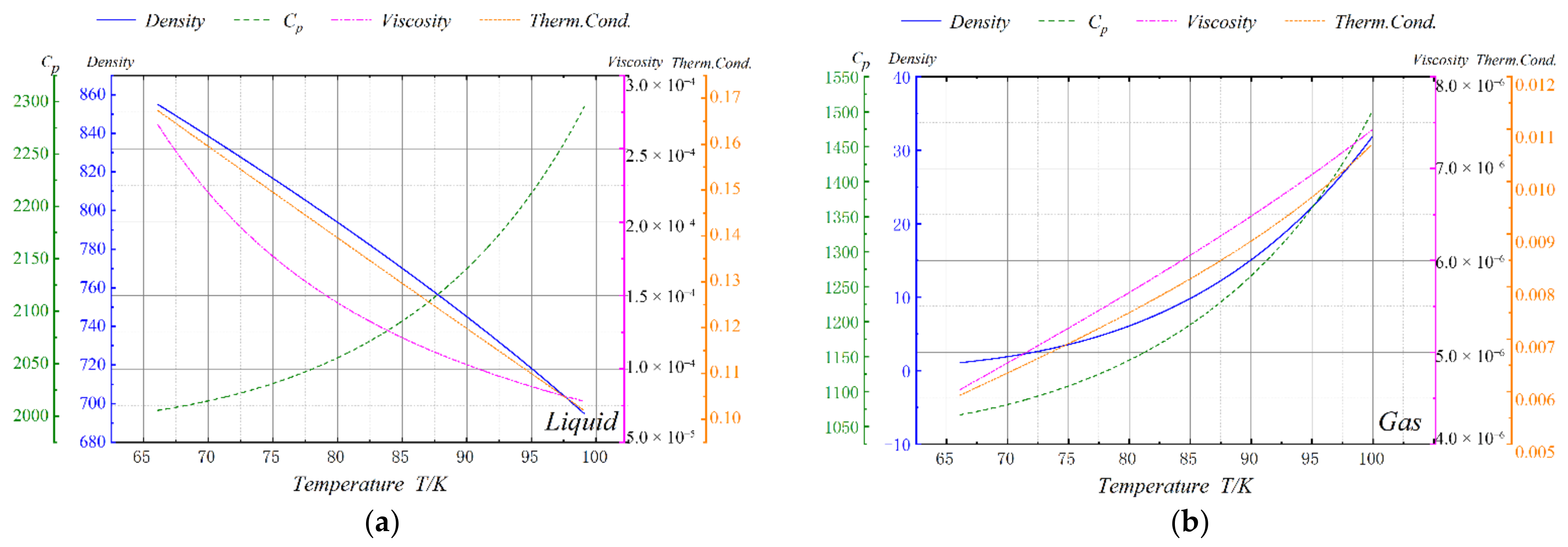

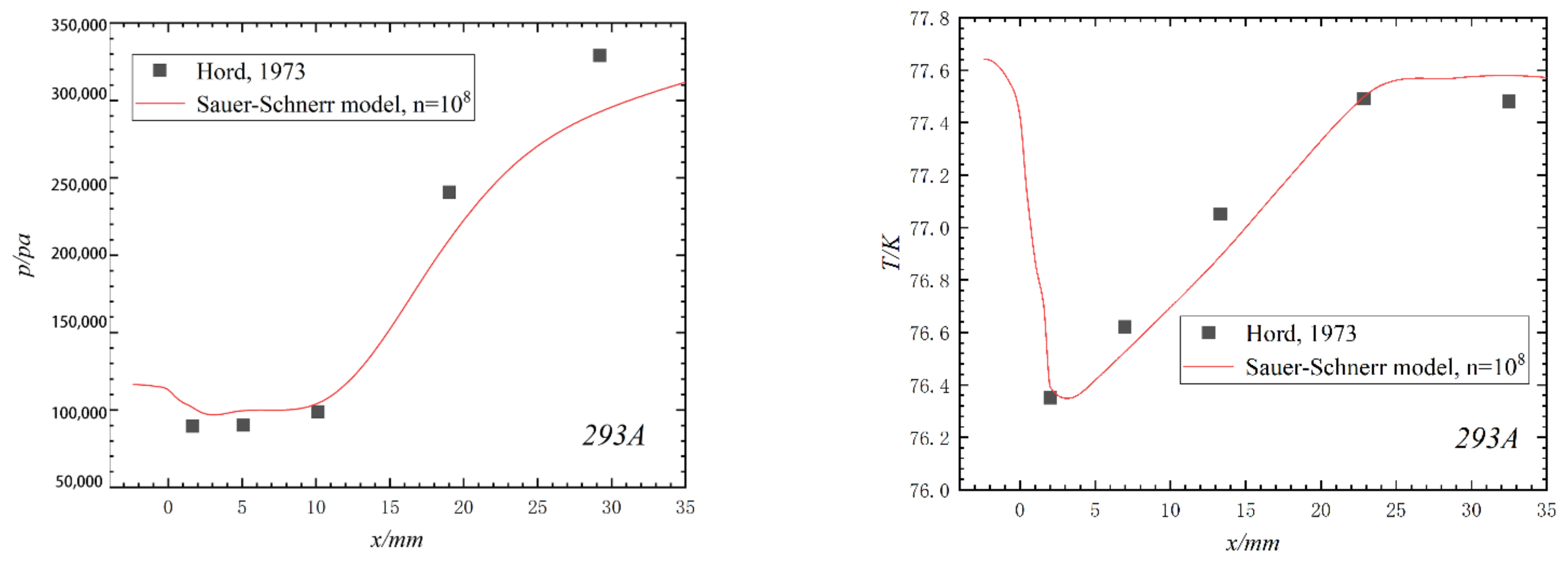

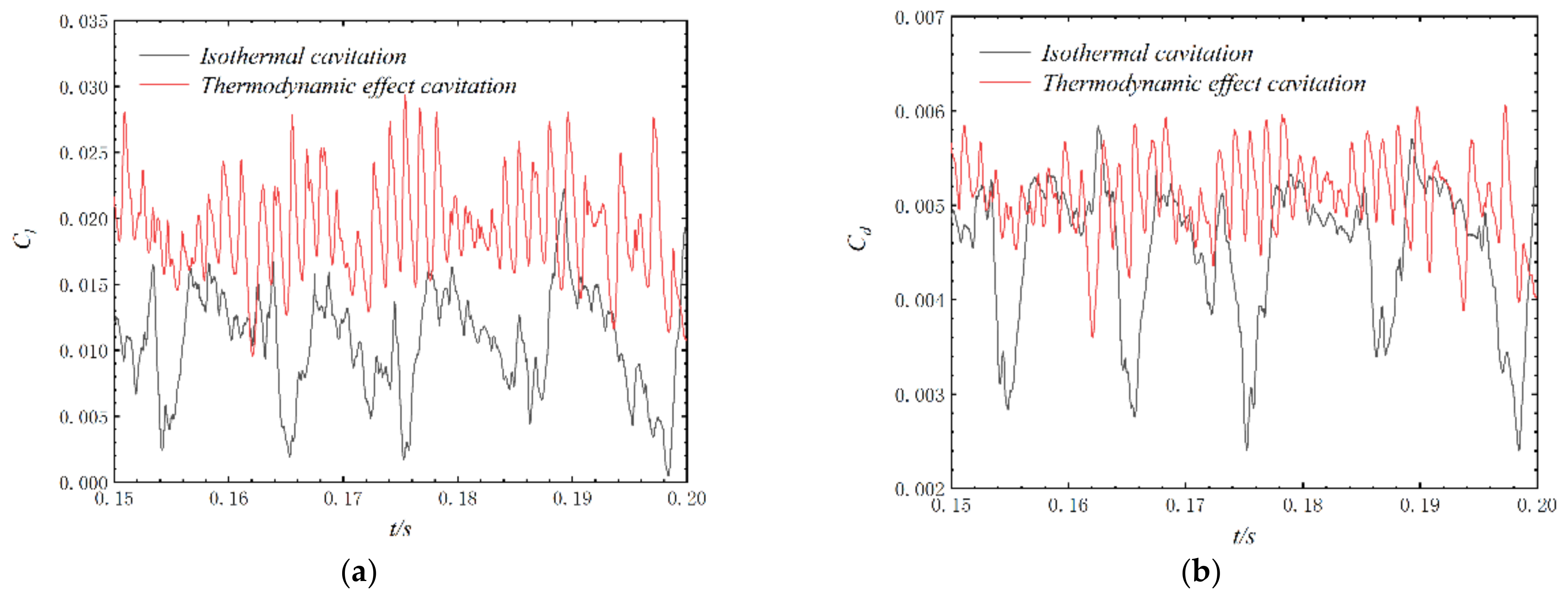
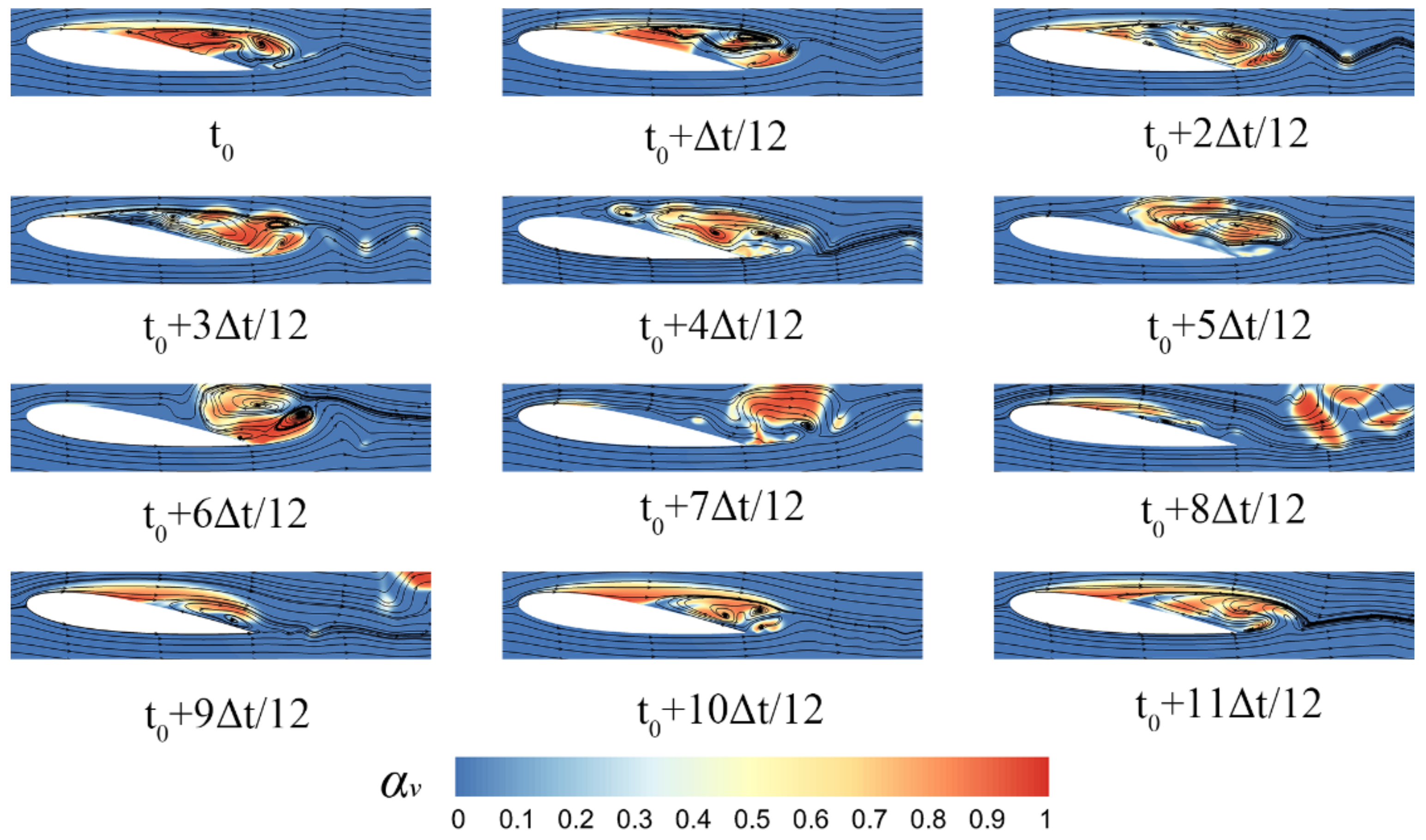
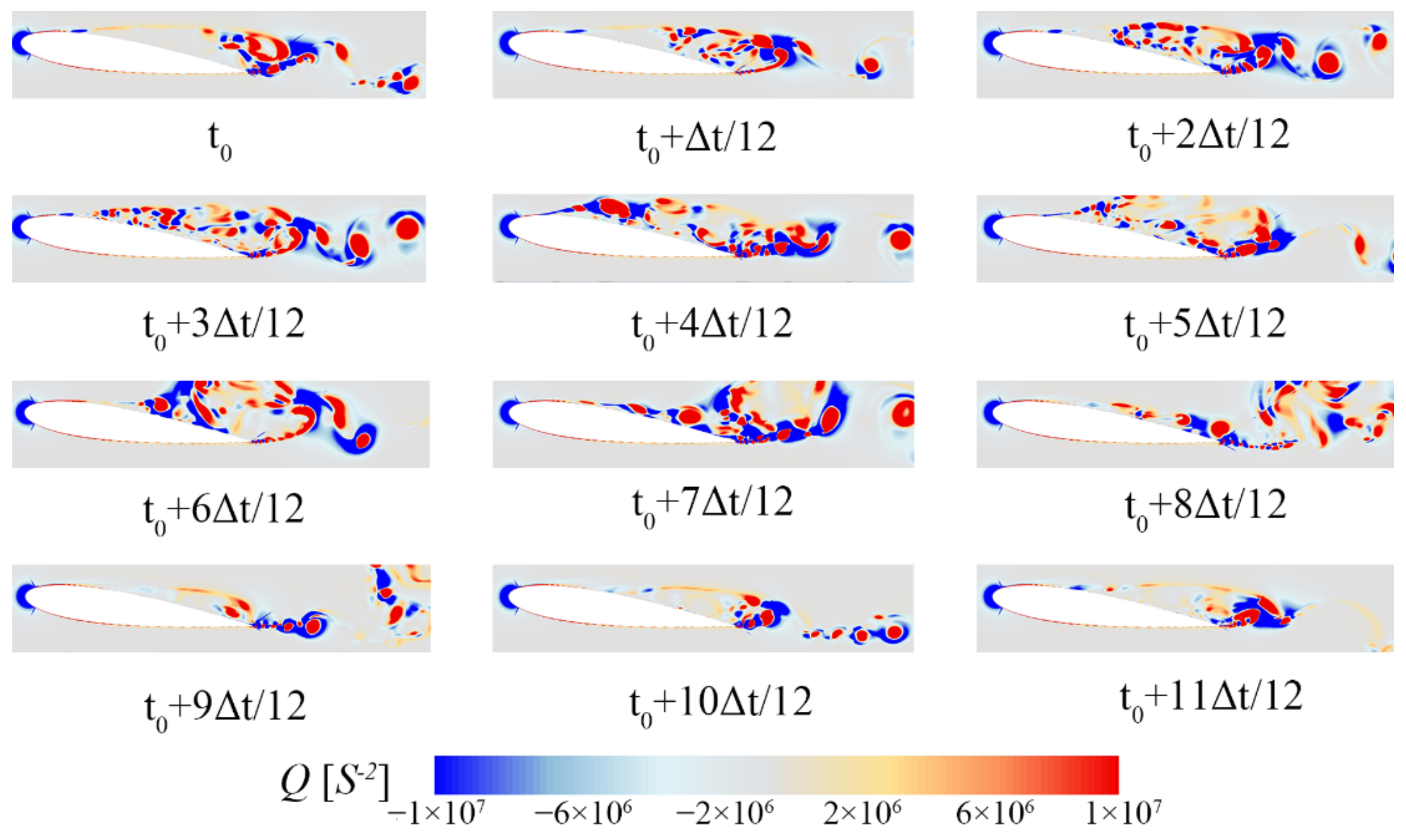
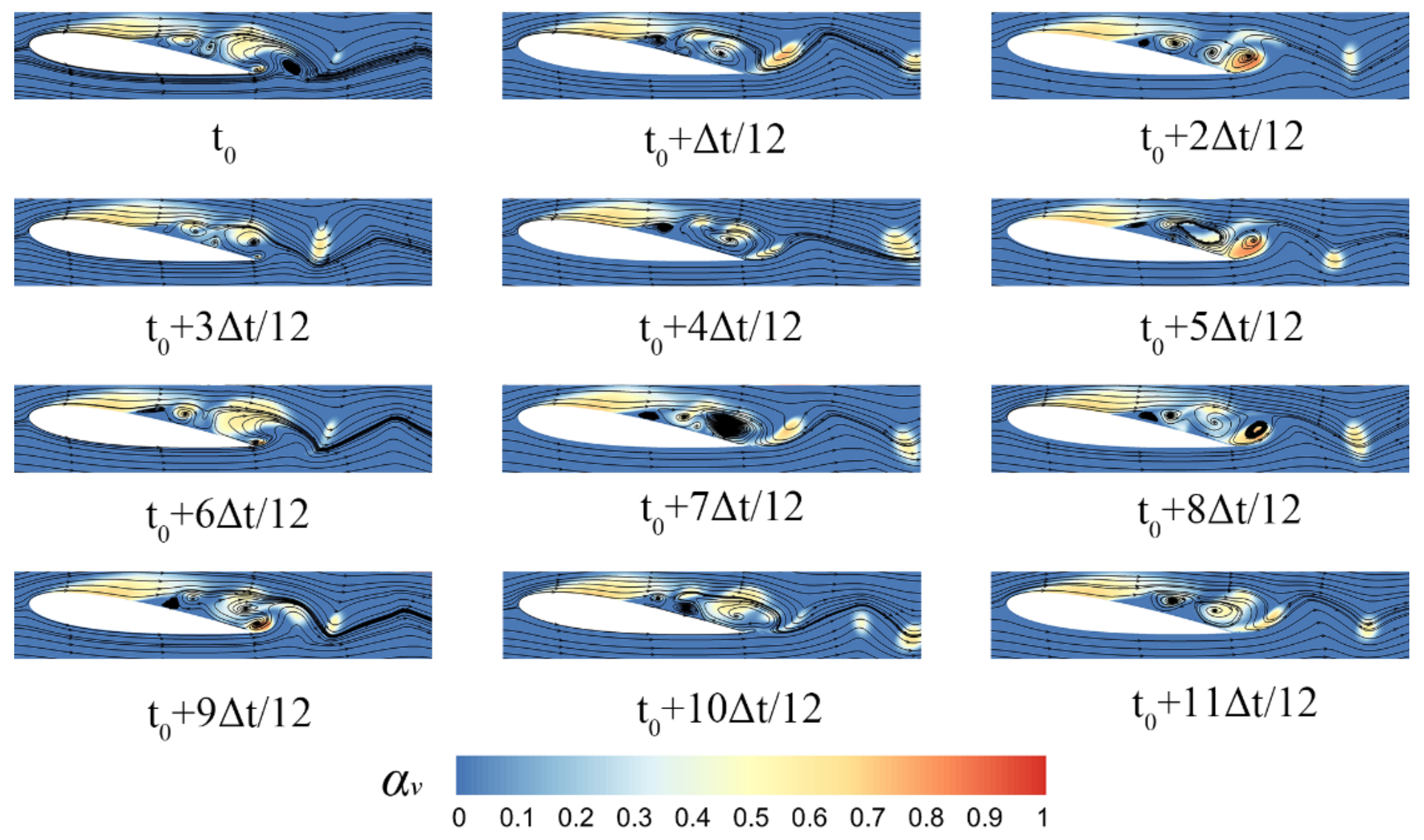
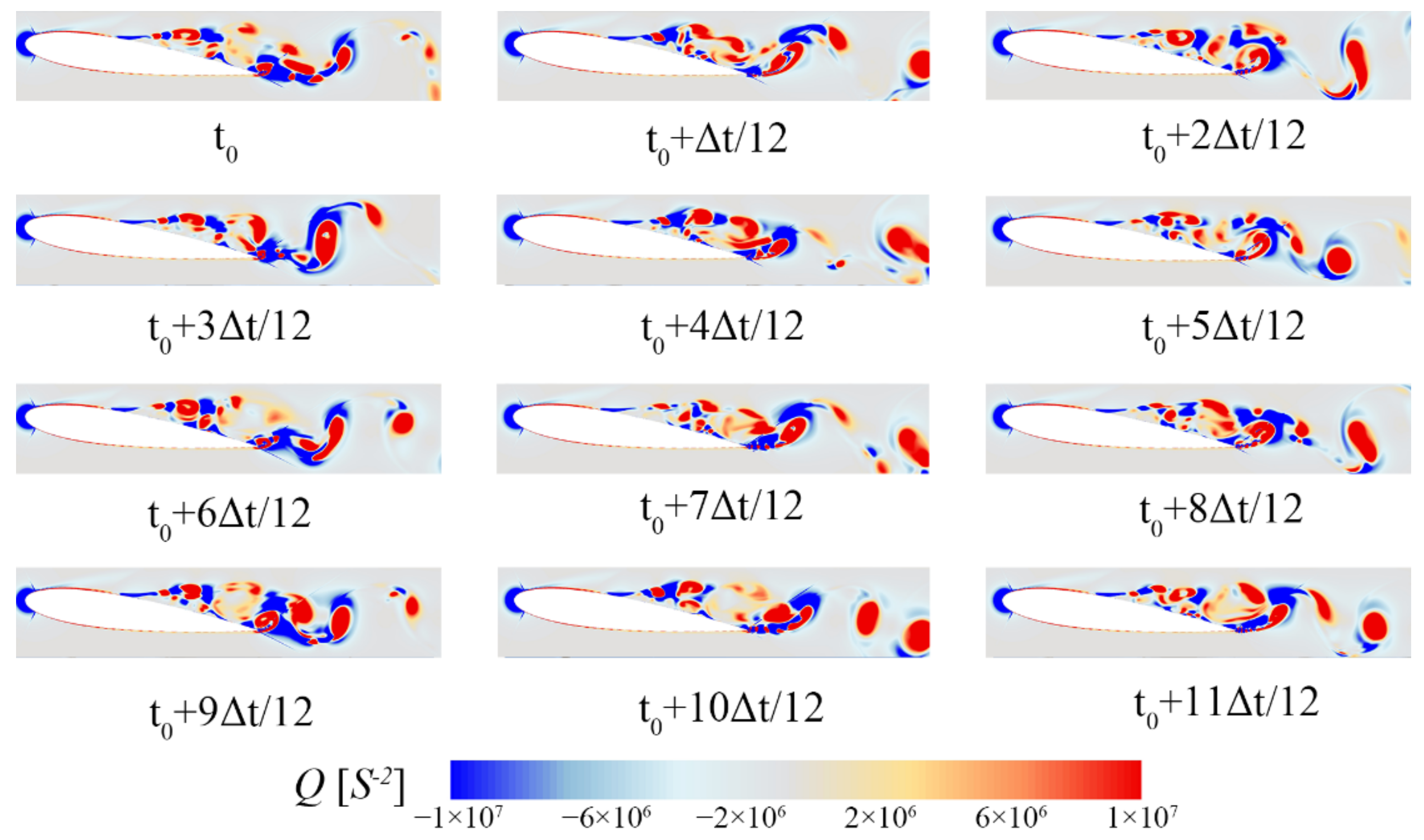
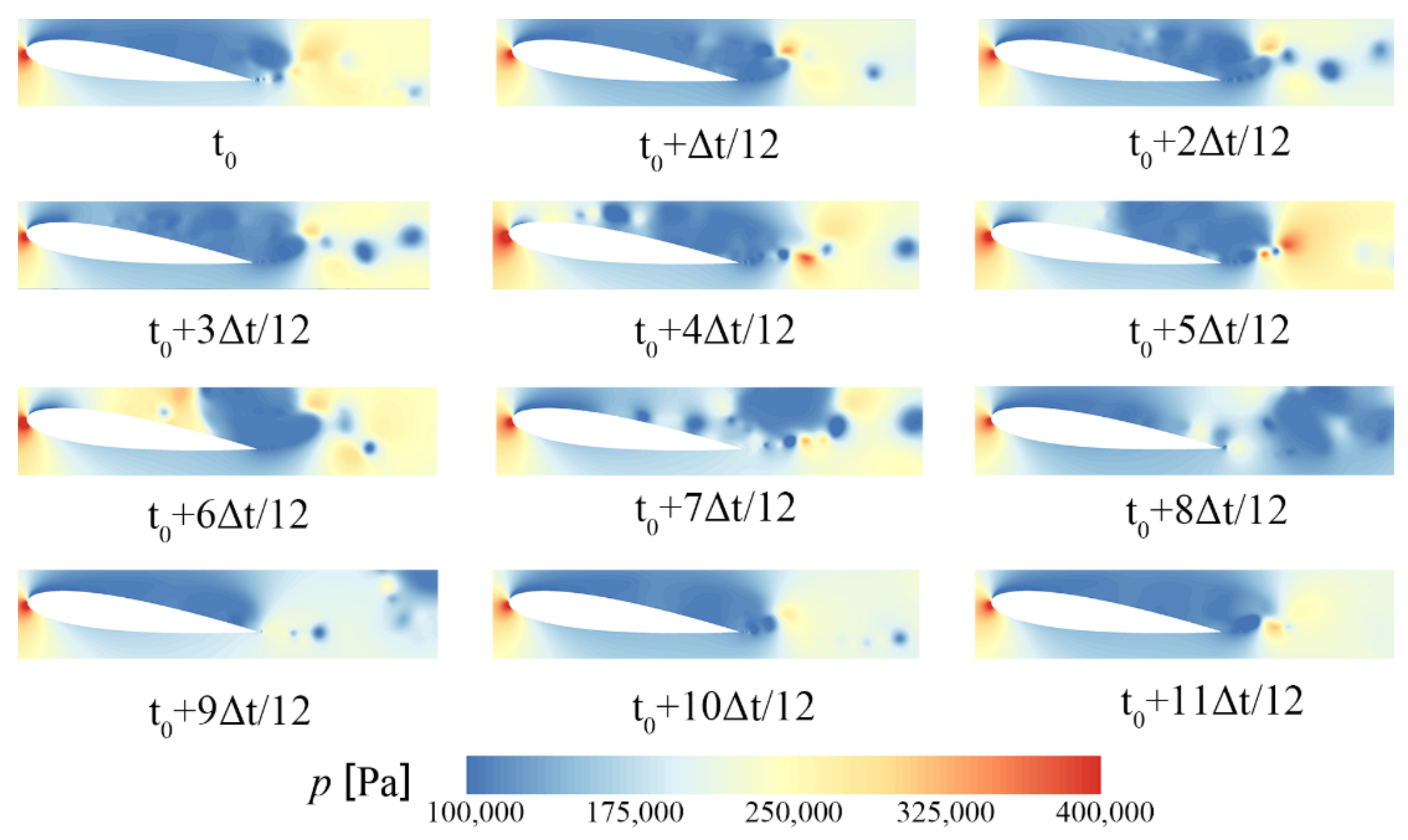

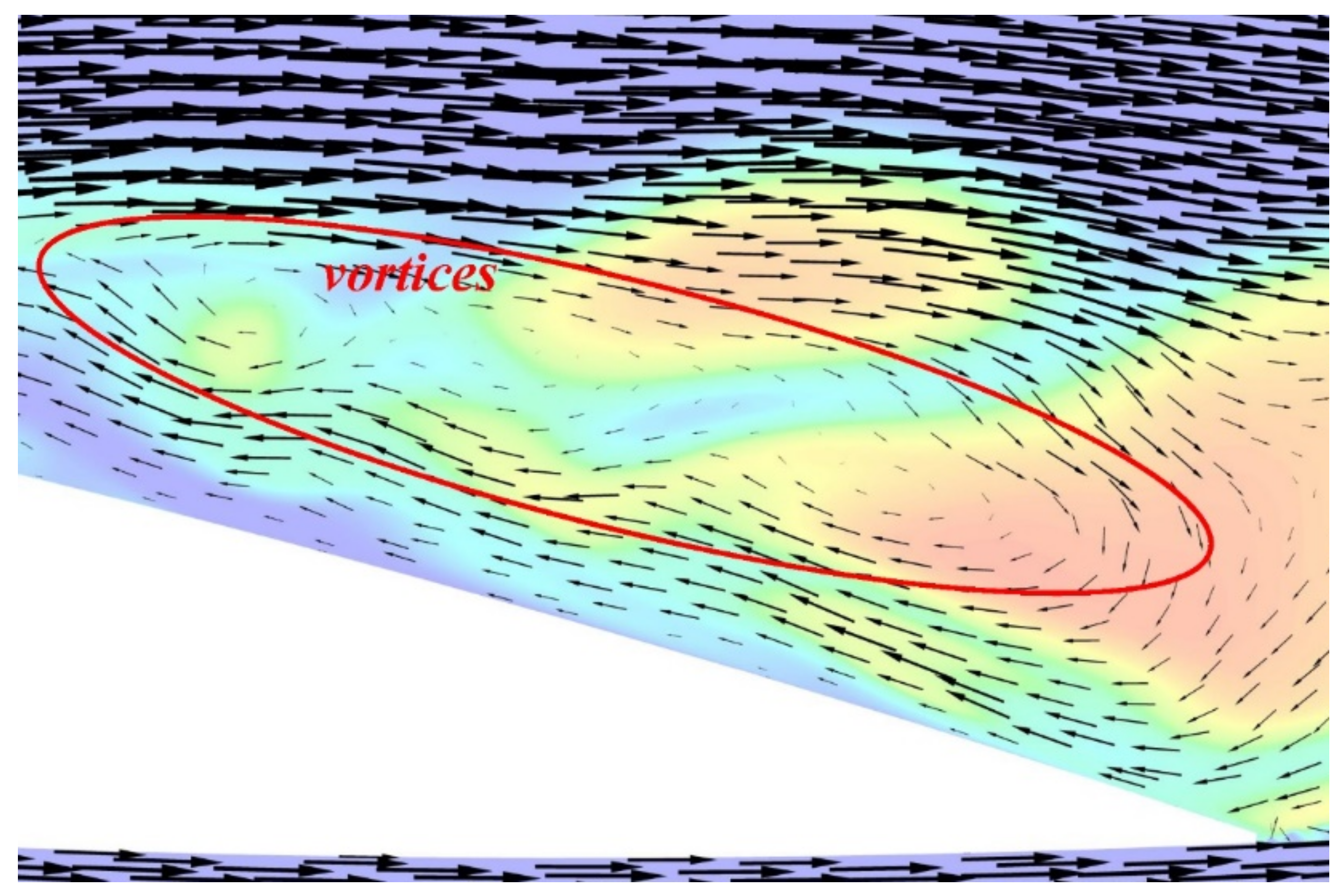

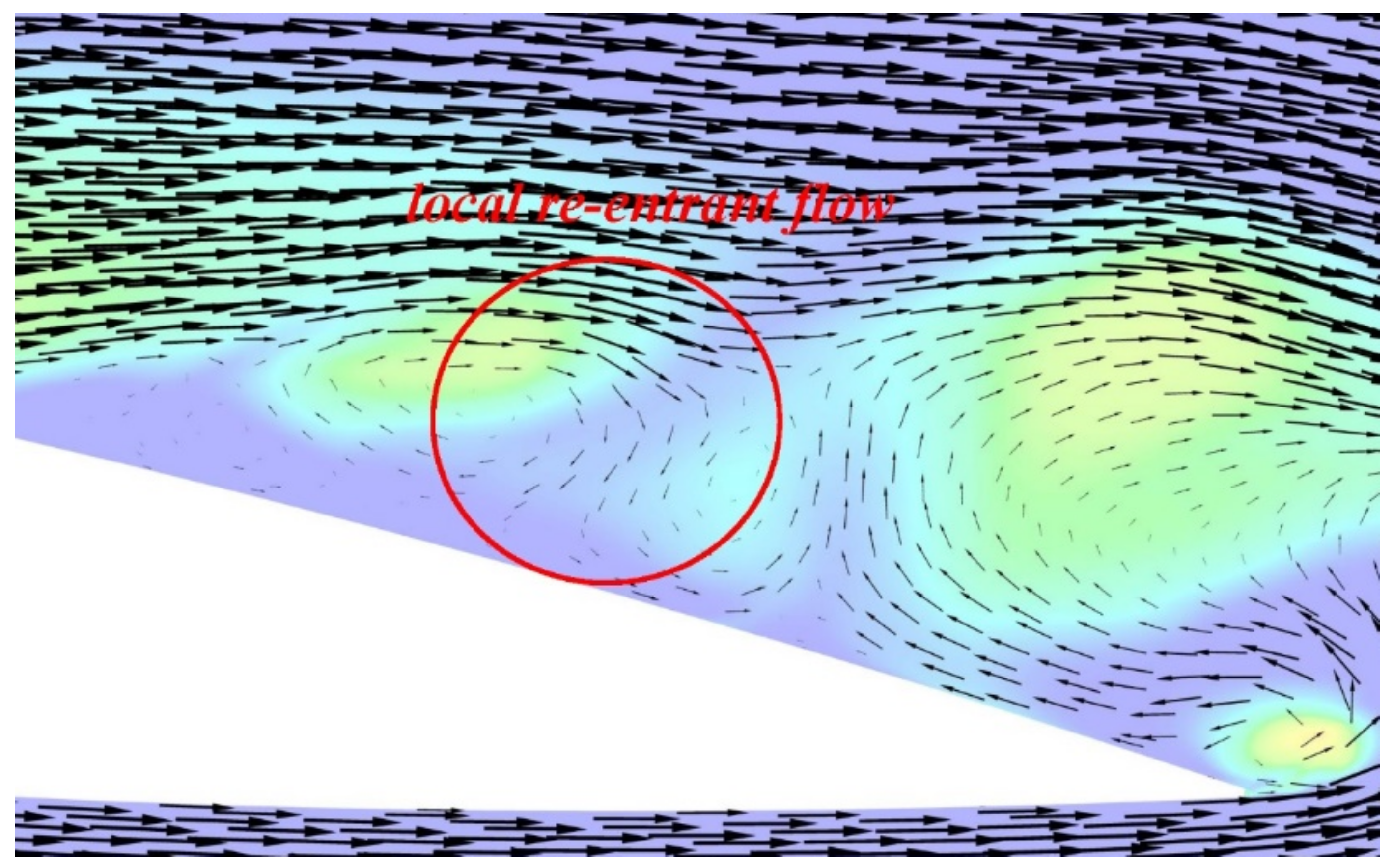
| Grid Division Schemes | Grid Number | Lift Coefficient Cl |
|---|---|---|
| 1 | 102,987 | 0.02298 |
| 2 | 215,875 | 0.02088 |
| 3 | 387,655 | 0.01880 |
| 4 | 477,732 | 0.01839 |
| 5 | 624,875 | 0.01828 |
| Medium | Number | Far-Field Temperature | Inlet Reynolds Number | Cavitation Number |
|---|---|---|---|---|
| liquid nitrogen | 293A | 77.64 K | 1.11 × 107 | 1.75 |
| liquid nitrogen | 296B | 88.54 K | 1.10 × 107 | 1.61 |
Disclaimer/Publisher’s Note: The statements, opinions and data contained in all publications are solely those of the individual author(s) and contributor(s) and not of MDPI and/or the editor(s). MDPI and/or the editor(s) disclaim responsibility for any injury to people or property resulting from any ideas, methods, instructions or products referred to in the content. |
© 2023 by the authors. Licensee MDPI, Basel, Switzerland. This article is an open access article distributed under the terms and conditions of the Creative Commons Attribution (CC BY) license (https://creativecommons.org/licenses/by/4.0/).
Share and Cite
Fu, Y.; Gao, B.; Ni, D.; Zhang, W.; Fu, Y. Study on the Influence of Thermodynamic Effects on the Characteristics of Liquid Nitrogen Cavitating Flow around Hydrofoils. Symmetry 2023, 15, 1946. https://doi.org/10.3390/sym15101946
Fu Y, Gao B, Ni D, Zhang W, Fu Y. Study on the Influence of Thermodynamic Effects on the Characteristics of Liquid Nitrogen Cavitating Flow around Hydrofoils. Symmetry. 2023; 15(10):1946. https://doi.org/10.3390/sym15101946
Chicago/Turabian StyleFu, Yuzhuang, Bo Gao, Dan Ni, Wenbin Zhang, and Yanxia Fu. 2023. "Study on the Influence of Thermodynamic Effects on the Characteristics of Liquid Nitrogen Cavitating Flow around Hydrofoils" Symmetry 15, no. 10: 1946. https://doi.org/10.3390/sym15101946
APA StyleFu, Y., Gao, B., Ni, D., Zhang, W., & Fu, Y. (2023). Study on the Influence of Thermodynamic Effects on the Characteristics of Liquid Nitrogen Cavitating Flow around Hydrofoils. Symmetry, 15(10), 1946. https://doi.org/10.3390/sym15101946







